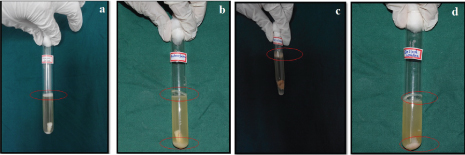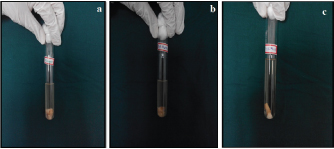Dental students perform preclinical training or clinical assignments on artificial tooth models, typhodont teeth and extracted human teeth. Many of the dental procedures are best learnt on human extracted teeth as they closely resemble the clinical situations [1].
Freshly extracted teeth are by their nature a potential source of cross contamination to laboratory equipments and personal, therefore, newly extracted teeth must be decontaminated [2].
The Centres for Disease Control and Prevention (CDC) has adopted guidelines for infection control of extracted teeth used for research and teaching, requiring that teeth be sterilized before use to minimize the risk of transmission of the blood borne pathogens [1] .
From past few decades various chemicals such as 10% Formalin, Sodium hypochlorite, Hydrogen peroxide and Glutaraldehyde have been tried for disinfection of extracted teeth with varying success [2–5]. Microwave radiation, Autoclave sterilization and Gamma radiation are the methods that are recommended for preventing cross contamination but are not viable for routine usage because they are laborious and time consuming. In most of the studies formalin storage has proven to be effective for infection control but it is a hazardous material and a potential carcinogen [5]. Therefore, a suitable alternative to formalin for storage and disinfection of extracted human teeth is essential.
To date only one study has assessed the effectiveness of vinegar as a disinfectant of extracted human teeth [1]. Since vinegar is a common household commodity which is non-carcinogenic and economical, the present study was conducted to evaluate whether vinegar can be used as a disinfectant for extracted teeth.
Materials and Methods
The present in-vitro study was conducted in Department of Oral and Maxillo Facial Pathology at Drs. Sudha and Nageswara Rao Siddhartha Institute of Dental Sciences, Andhra Pradesh, India, in the month of May 2015. A total of 40 freshly extracted, due to Orthodontic and Periodontal reasons, human non-carious and unrestored teeth were taken from the Department of Oral and Maxillofacial Surgery. Teeth were randomly divided into one of the following eight groups (5 teeth per group) and were placed in 20ml of disinfectant solution for seven days. Group distribution was as follows:
Group 1- Commercially available vinegar
Group 2 - 10% Formalin
Group 3 - 3% Hydrogen peroxide
Group 4 - 5.25% Sodium hypochlorite
Group 5 - 70% Alcohol
Group 6 - Kept in boiling water at 100°C for 20 mins
Group 7 - Autoclaved at 121°C at 15lbs psi for 30 mins
Group 8 - As a control in normal saline
After the disinfection process disinfectant was discarded and the tooth samples were transferred in sterile saline for 60 seconds. Then teeth from each group were incubated individually in separate test tubes containing 10ml of brain heart infusion broth (HIMEDIA) at 37°C for 48 hours.
Evidence of microbial growth in the broth was visible as turbidity in the sample and it was observed after two days. No visible growth in the broth was considered as effective disinfection. The results were statistically analyzed using Kruskal-Wallis test.
Results
The broth was observed for all eight groups at the end of 48hr period. Evidence of turbidity in the broth indicated microbial growth and hence, ineffective disinfection [Table/Fig-1a-d]. Nutrient broth was clear and hence indicated effective disinfection [Table/Fig-2a-c]. The results have been displayed in [Table/Fig-3]. Kruskal-Wallis analysis of the data showed statistically significant difference in the outcomes when comparing the various methods of disinfection and sterilization [Table/Fig-3]. Out of the eight disinfectants used in the present study Groups I, II and III have higher proportion of disinfected teeth compared to other groups put together, whereas Groups VI and VIII have lesser proportion of disinfected teeth compared to other groups put together.
Turbidity in the sample. Red colour circle indicates turbidity in the broth.

No evidence of turbidity in the sample.

Efficacy of different disinfectant solutions in relation to growth in the samples.
| Groups | Disinfectants | Number of Teeth | Duration | Number of Teeth Disinfected | Number of Teeth not Disinfected | H Value | p-value |
|---|
| Group 1 | Vinegar | 5 | 7 Days | 5 | 0 | 28.053, | <0.001 (HS) |
| Group 2 | 10% Formalin | 5 | 7 Days | 5 | 0 |
| Group 3 | 3% H202 | 5 | 7 Days | 5 | 0 |
| Group 4 | 5.25% NaOCL | 5 | 7 Days | 1 | 4 |
| Group 5 | 70% Alcohol | 5 | 7 Days | 1 | 4 |
| Group 6 | Boiling Water | 5 | 20 Minutes | 0 | 5 |
| Group 7 | Autoclaving | 5 | 30 Minutes | 2 | 3 |
| Group 8 | Normal Saline | 5 | 7 Days | 0 | 5 |
Kruskal-Wallis test was used to compare between groups.
These results were statistically significant with Kruskal–Wallis test value 28.053 and p-value 0.001.
Discussion
Extracted teeth are collected and frequently used in dental education settings. For safe usage of these teeth it is necessary to subject them to disinfection/sterilization and proper storage to ensure they are free of biological residues [6].
It is proven that many blood borne pathogens are viable in the root canals for a considerable period of time [2]. These pathogens include bacteria, viruses like Hepatitis B, C and HIV [1].
In the present study disinfectants like Vinegar, 10% Formalin, 3% Hydrogen Peroxide (H2O2), 70% Alcohol and 5.25% NaOCl and other procedures such as autoclaving for 30mins at 121°C and 15 lbs pressure, immersion in boiling water for 20 mins at 100°C were used for disinfection of the extracted teeth and normal saline was taken as a control. Among all the disinfectants used Vinegar, 10% Formalin and 3% Hydrogen peroxide were found to be effective in disinfecting all the tooth samples when immersed for seven days.
Vinegar is a liquid consisting mainly of 5% acetic acid (CH3COOH) and water. It crosses the cell membrane of bacteria which denatures the proteins and fats causing release of protons, which leads to cell death. Our results were in accordance with Tijare et al., who reported that vinegar could be used as storage and disinfectant medium for extracted human teeth [1].
Formalin is composed of methyl alcohol, formaldehyde and sodium acetate in water. It preserves tissues by cross linking proteins, glycoproteins, nucleic acid and polysaccharides to form insoluble methylene bridge products [7]. In this study 10% Formalin was used and proved to be an effective disinfectant when teeth were immersed for seven days. These results were consistent with previous studies [1,2,3,8]. Although it is an effective disinfectant but a potential carcinogen, thus care should be exercised by using protective personnel equipment.
Our study showed that 3% H2O2 was effective in disinfecting all the samples when immersed for seven days as it has a good bactericidal property which was in support with Tijare et al., [1].
NaOCl 5.25% was not effective in disinfecting all the tooth samples. NaOCl is composed of a sodium cation and a hypochlorite anion, when dissolved in water it is commonly known as bleach and is frequently used as disinfectant or a bleaching agent. Similar observations were noted by Tijare et al., [1] who also reported that Sodium hypochlorite may increase enamel porosity and alter dentin structure which could nullify the use of teeth stored in this solution [9,10]. This is in contrast with the studies by Nikita et al., Kumar et al., and Rita et al., [8] who reported that 5.25% NaOCl was effective in disinfecting all the tooth samples [2,3,8].
The autoclaving process of sterilization is considered as a gold standard method for disinfection for many years. Studies conducted using this technique at different temperatures have proved that this is the most effective method for disinfection [2,3,8]. But in the current study, autoclaving for 30 mins at 121°C and 15 lbs pressure was 50% effective, which may be due technical errors like variations in time period, temperature, and quality control and up and downs of the electric voltage. This might be the reason that autoclaving in the present study showed inferior results in disinfecting all the extracted teeth. To prevent the complications associated with autoclave sterilization, daily maintenance, proper supervision of temperature and pressure, and placement of autoclave at proper position are to be strictly followed in the institutions. The institutional authorities were informed about this situation and necessary steps are being employed.
Immersion in boiling water for 20 min at 100°C was not effective in disinfecting the tooth samples. Similar results have been observed in previous studies as well [2,3,8].
Vinegar was 100% effective disinfectant for extracted teeth and it was found to be superior to other disinfectants. Also it has added advantages of being non-carcinogenic, economical and eco-friendly. Dental students and researchers should be aware of CDC guidelines while handling extracted teeth to prevent cross infection.
In future, further research with larger sample size and evaluation of the surface alterations of teeth caused by vinegar should be evaluated to establish vinegar as effective disinfectant for handling extracted human teeth.
Limitation
Limitations in the present study was that the disinfectant solutions at different concentrations were not assessed and the physical properties of teeth like surface alterations, bond strengths were not evaluated.
Conclusion
The present study proved that vinegar can be used as an effective disinfectant for extracted human teeth. Due its non-hazardous property, it can be used safely in preclinical and clinical studies.
Kruskal-Wallis test was used to compare between groups.